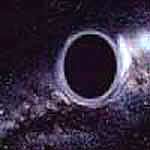"Black Holes" pose another problem
 The brightest objects in the Universe emerge in relatively small galaxies. According to the recent discovery, giant black holes originated rather quickly after the Great Explosion; they also grew at a much faster pace than the surrounding galaxies.
The brightest objects in the Universe emerge in relatively small galaxies. According to the recent discovery, giant black holes originated rather quickly after the Great Explosion; they also grew at a much faster pace than the surrounding galaxies.

Based on today's most widely accepted theory, Quasars (the name “quasar” comes from the phrase “quasi-stellar radio source) are in fact massive black holes, intensively devouring gas and stars of its neighboring galaxies. Today, such giant black holes can be observed only in vast galaxies; however majority of quasars first appeared in times when the Universe was three times younger.
Those galaxies, the predecessors of modern galaxies used to be much smaller in size. International team of astronomers with the help of their telescope “Gemini” managed to examine nine quasars, situated more than 10 billion years away. They also managed to discern the galaxies when the Universe was approximately 4 billion years old. Scientists separated the actual light of the quasars in order to see what their galaxies looked like. As it turned out, that only one galaxy was big enough and projected the most light for the scientists to spot it. Even that galaxy appeared average in size, just like ours.
Limited dimensions of the galaxies puzzled the astronomers. More so, the scientists did not find any traces of the galaxies fusion, which are considered to launch the process of the substance consumption by giant black holes. On the contrary, it appeared to them that a never-ending flow of gas nourishes those galaxy nuclei.
Most interestingly, those distant quasars project 50 times more light than the neighboring younger quasars. What this means is whether those galaxies more actively consumed the substance, or whether those distant black holes are in fact 10 times greater in size. The authors prefer to stick with the latter; however, how those ancient black holes reached their sizes remains a mystery, reports NTR.ru.
Subscribe to Pravda.Ru Telegram channel, Facebook, RSS!


